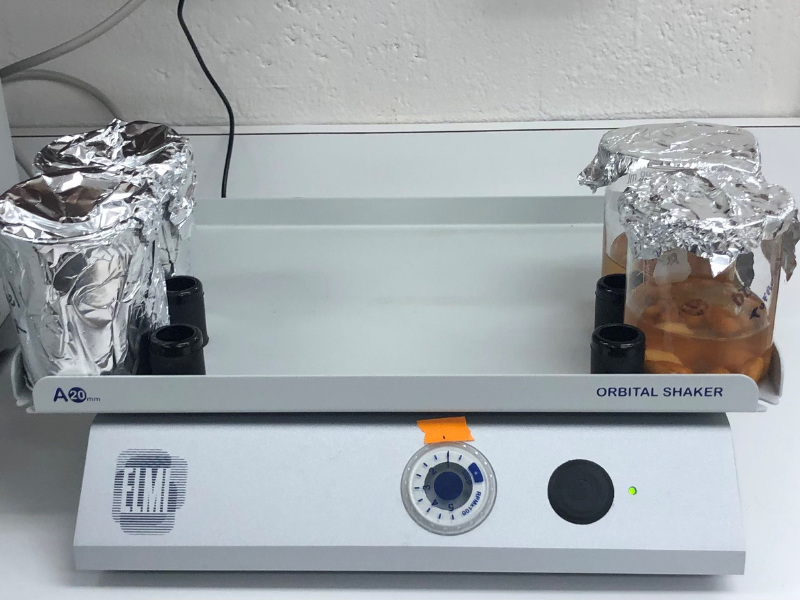USA
August 22, 2023
Plants suffer from drought stress when they do not have sufficient water for their growth and reproduction. Drought stress can cause food crops to become less productive, not produce a crop at all, or even die. Drought stress is a major problem in places where crop production mainly relies upon rainfall to supply crop needs. The August 22nd Sustainable, Secure Food Blog looks at promising research that may help crops cope with drought stress.
The weather cannot be controlled, but to some extent, plants can. Since they cannot move, plants need to adjust and adapt to changes in their environment, such as drought, high temperature, or salt. Scientists are trying to use this ability to help plants respond to stress faster or more effectively to improve production and survival.

Peanut seeds soaking in solution (left: Melatonin primed seeds, right: not primed seeds in deionized water). Melatonin-primed seeds are covered with aluminum foil to protect them from light since melatonin is reactive to light. Credits: Aline de Camargo Santos
Although plants do not have brains or a nervous system, they can ‘remember’ the stress after experiencing it multiple times through a process called “stress memory.” The repetition of the stress ‘trains’ the plant to recognize the stress when it happens again.
Plant physiologists – scientists who study how plants function - are trying to use stress memory to improve crops’ tolerance to drought stress. One approach to prepare plants to stress before it occurs is by “priming” them. Although not exactly the same, the idea of priming is like administering a vaccine to the plant.
Just as vaccines give a small amount of a virus to activate our immune system, we expose plants to low levels of stress to activate stress responses. When people get vaccinated, they may experience some symptoms but recover after a short time. Then, if exposed to the virus, that person will have immunity and generally not experience severe symptoms.
Primed plants show a similar response. During the priming treatment, they show mild stress symptoms such as slight wilting or lower metabolic activity. Ideally, the priming treatment does not reduce growth but alerts the plant to be prepared for stress. Once the plants are returned to normal conditions, they recover and are ready to perform better if the stress occurs later in the growth cycle.
Aline de Camargo Santos, University of Florida, researches “priming” to increase peanut tolerance to drought stress by testing two different priming techniques. In the first approach, we apply mild water stress at the beginning of the crop cycle as a priming treatment. Primed plants receive less than the recommended irrigation for peanut during the priming period, which is about 2-3 weeks. After that, the plants receive plenty of water, so they can recover and build their defense system. Later in the season, we stress the plants again by completely stopping all irrigation to test if the priming treatment increases stress tolerance. After that, we harvest the plants, and the productivity of the primed and not primed plants is compared. This approach can potentially reduce the amount of irrigation applied while maintaining yield and increasing the peanut plants’ stress tolerance.
In the second approach, we prime seeds before planting with naturally occurring plant natural chemical compounds that the plants already use to signal stress and activate stress responses. Melatonin, abscisic acid, and salicylic acid are some examples of these compounds.
The germination process is considered quite stressful for the seed. The seeds must absorb a lot of water in a short time to produce the first leaves and establish the root system. For this method, seeds are primed by treating them with a melatonin solution for a few hours. That allows the seeds to absorb as much water as they need from the solution. The seeds also absorb some melatonin that helps them to prepare to germinate. Preliminary results from this research show improved and more uniform early establishment and vigor in young plants. Once melatonin-primed plants are exposed to stress, they are healthier than the not-primed plants and potentially show improved tolerance against drought stress.
Drought stress impact on crop production is complex and unlikely to be solved with a single method. Therefore, diverse strategies need to be developed to address the problem. The use of priming is one way we can improve how crops are produced under drought conditions. Further research is necessary to understand priming and to adjust all aspects of the method (effective stress levels, duration of the priming treatment, and timing of application) specifically for each crop and production environment.
To read more about the research findings and the entire blog, visit: https://sustainable-secure-food-blog.com/2023/08/22/what-is-current-research-in-drought-preparation/